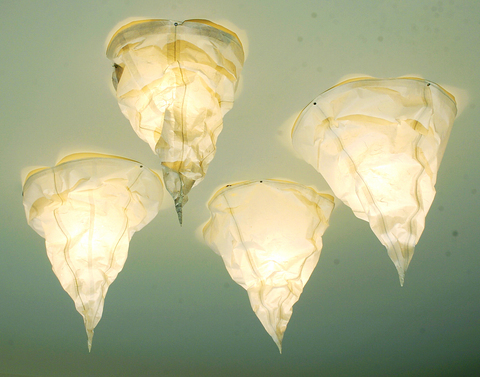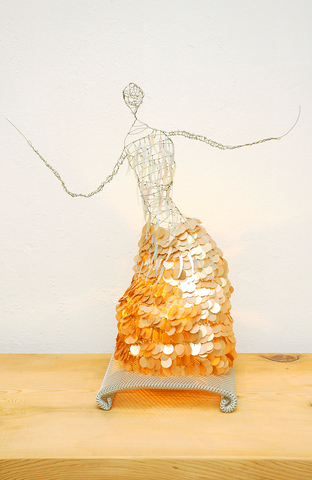According to Chen Ming-nung (
Chen lives in Pali (
In the bathroom, the concrete floor is paved with local stone. The dining table is made of piled-up ceramic tiles, and 10 or so carved fish-shaped pieces of driftwood surround a lamp.

PHOTO: PAN SHAO-TANG, TAIPEI TIMES
In the lounge, huge glass windows let in the sunshine. There are cabinets of cement mixed with ocean-washed bricks.
Chen said that the inspiration for most of his creations simply came to him from things he found lying around. Given the creativity that surrounds him, it is no surprise that Chen is content to spend his days in such surroundings.
Chen's works show an original talent. He said that, growing up near Pachang River (

PHOTO: CHEN JUN-LIANG, TAIPEI TIMES
To make a living from his lifestyle, Chen has "commercial works, which are distinct from his personal works." But, he said, all of them are just as precious to him and every time he sells something he feels a pang of sorrow.
Chen's work is available through Eslite and he has occasional solo exhibitions.
Hand-wrought
A-deng's (
His works are scattered all over the studio and each piece of art seems to have its own designated corner. Apart from these pieces, almost everything in the studio, including door knobs, windows, floors, desks, and chairs are handmade by A-deng.
His work, including old-fashioned copper oil lamps, slate wall clocks and unique lamps are sold in home decoration stores all over Taiwan.
He said that these products are 70 percent to 80 percent aesthetically pleasing and just 10 percent to 20 percent utilitarian.
A-deng said half jokingly, "People say that there is one distinguishing characteristic of my lamps and also one characteristic of my clocks -- the heat of the lamps can scald your hands and the clocks may not keep the right time, and may suddenly run down."
He said that design is everything and he did not want to be hampered by conventional elements such as switches.
A-deng began his artistic career over 10 years ago. He started by installing light bulbs inside egg shells. Since then, his output has been enormous.
cruising
Cruising down Teng-hui Boulevard, in Danshui, rows of anonymous houses confront travelers, but breaking the monotony is Chang Yung-sheng's (
Leading to the entrance of Chang's house is a patch of turf paved with stone.
Chang, whose father is from China, grew up scrimping and saving to sustain his family. He is used to turning out items which many consider to be rubbish into something artistic or useful.
Influenced by his father's generation, Chang believes that with some polishing and refinement, even a piece of junk can be transformed into something splendid. Pointing to a piece of driftwood, "it is simply lovely to feel the wood's texture with your hands."
In an age of mass-produced consumables these three artists' works show that tradition and creativity have not completely fallen by the wayside.
With additional reporting by Chen Jun-liang, Tai Da-Hsiang, and Pan Shao-tang Translated by Lin Ya-ti, Daniel Cheng and Ian Bartholomew

In the March 9 edition of the Taipei Times a piece by Ninon Godefroy ran with the headine “The quiet, gentle rhythm of Taiwan.” It started with the line “Taiwan is a small, humble place. There is no Eiffel Tower, no pyramids — no singular attraction that draws the world’s attention.” I laughed out loud at that. This was out of no disrespect for the author or the piece, which made some interesting analogies and good points about how both Din Tai Fung’s and Taiwan Semiconductor Manufacturing Co’s (TSMC, 台積電) meticulous attention to detail and quality are not quite up to

April 21 to April 27 Hsieh Er’s (謝娥) political fortunes were rising fast after she got out of jail and joined the Chinese Nationalist Party (KMT) in December 1945. Not only did she hold key positions in various committees, she was elected the only woman on the Taipei City Council and headed to Nanjing in 1946 as the sole Taiwanese female representative to the National Constituent Assembly. With the support of first lady Soong May-ling (宋美齡), she started the Taipei Women’s Association and Taiwan Provincial Women’s Association, where she

Chinese Nationalist Party (KMT) Chairman Eric Chu (朱立倫) hatched a bold plan to charge forward and seize the initiative when he held a protest in front of the Taipei City Prosecutors’ Office. Though risky, because illegal, its success would help tackle at least six problems facing both himself and the KMT. What he did not see coming was Taipei Mayor Chiang Wan-an (將萬安) tripping him up out of the gate. In spite of Chu being the most consequential and successful KMT chairman since the early 2010s — arguably saving the party from financial ruin and restoring its electoral viability —

It is one of the more remarkable facts of Taiwan history that it was never occupied or claimed by any of the numerous kingdoms of southern China — Han or otherwise — that lay just across the water from it. None of their brilliant ministers ever discovered that Taiwan was a “core interest” of the state whose annexation was “inevitable.” As Paul Kua notes in an excellent monograph laying out how the Portuguese gave Taiwan the name “Formosa,” the first Europeans to express an interest in occupying Taiwan were the Spanish. Tonio Andrade in his seminal work, How Taiwan Became Chinese,